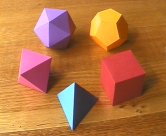Difference between revisions of "Polyhedron"
SeanTheSheep (Talk | contribs) m (spelling) |
m (linked tetrahedron) |
||
| (10 intermediate revisions by 9 users not shown) | |||
| Line 1: | Line 1: | ||
A '''polyhedron''' is a three dimensional shape which is bounded by [[polygon]]s. | A '''polyhedron''' is a three dimensional shape which is bounded by [[polygon]]s. | ||
| − | + | [[Image:PlatonicSolids.jpg|right|600px|thumb|The five regular convex polyhedra, also known as the Platonic Solids]] | |
| − | *The tetrahedron ("tetra-" meaning "four") | + | A regular polyhedron is a polyhedron all of whose faces are identical regular polygons, and all of whose vertices have the same number of faces around each vertex. There are only five regular convex polyhedra—polyhedra in which the all of the faces are on the outside of the polyhedron.<ref>As opposed to four "star polyhedra" in which the "faces" of the polyhedron slice into the polyhedron</ref> They are: |
| + | |||
| + | *The [[tetrahedron]] ("tetra-" meaning "four") | ||
*The cube or hexahedron ("hexa-" meaning "six") | *The cube or hexahedron ("hexa-" meaning "six") | ||
*The octahedron ("octa-" meaning "eight") | *The octahedron ("octa-" meaning "eight") | ||
| Line 9: | Line 11: | ||
*The icosahedron ("icosa-" meaning "twenty") | *The icosahedron ("icosa-" meaning "twenty") | ||
| − | Role-playing games often use dice in the shape of | + | Role-playing games often use dice in the shape of tetrahedra, octahedra, dodecahedra, and icosahedra, as well as traditional cubical dice and nonregular decahedra. |
Because the dodecahedron has twelve sides, decorative calendars are sometimes made in the shape of a dodecahedron, with one month printed on each face. | Because the dodecahedron has twelve sides, decorative calendars are sometimes made in the shape of a dodecahedron, with one month printed on each face. | ||
==Notes== | ==Notes== | ||
| + | |||
| + | For a full description of polyhedra see: http://mathworld.wolfram.com/Polyhedron.html | ||
| + | |||
<references/> | <references/> | ||
[[Category:Geometry]] | [[Category:Geometry]] | ||
Latest revision as of 17:01, June 16, 2019
A polyhedron is a three dimensional shape which is bounded by polygons.
A regular polyhedron is a polyhedron all of whose faces are identical regular polygons, and all of whose vertices have the same number of faces around each vertex. There are only five regular convex polyhedra—polyhedra in which the all of the faces are on the outside of the polyhedron.[1] They are:
- The tetrahedron ("tetra-" meaning "four")
- The cube or hexahedron ("hexa-" meaning "six")
- The octahedron ("octa-" meaning "eight")
- The dodecahedron ("dodeca-" meaning "twelve")
- The icosahedron ("icosa-" meaning "twenty")
Role-playing games often use dice in the shape of tetrahedra, octahedra, dodecahedra, and icosahedra, as well as traditional cubical dice and nonregular decahedra.
Because the dodecahedron has twelve sides, decorative calendars are sometimes made in the shape of a dodecahedron, with one month printed on each face.
Notes
For a full description of polyhedra see: http://mathworld.wolfram.com/Polyhedron.html
- ↑ As opposed to four "star polyhedra" in which the "faces" of the polyhedron slice into the polyhedron
